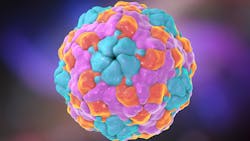Human Parechovirus (PeV) circulating in the U.S.
The Centers for Disease Control and Prevention (CDC) is issuing a Health Alert Network (HAN) Health Advisory to inform clinicians and public health departments that parechovirus (PeV) is currently circulating in the United States.
Since May 2022, CDC has received reports from healthcare providers in multiple states of PeV infections in neonates and young infants. Parechoviruses are a group of viruses known to cause a spectrum of disease in humans. Clinicians are encouraged to include PeV in the differential diagnoses of infants presenting with fever, sepsis-like syndrome, or neurologic illness (seizures, meningitis) without another known cause and to test for PeV in children with signs and symptoms compatible with PeV infection (see below). Commercial laboratory assays, multiplex platforms for meningitis and encephalitis, and testing through state public health laboratories (SPHLs) are available to test cerebrospinal fluid (CSF) for PeV to confirm a diagnosis. CDC laboratory support is also available for testing and typing patient specimens.
To date, all PeV positive specimens tested and typed at CDC were type PeV-A3. Because there is presently no systematic surveillance for PeVs in the United States, it is not clear how the number of PeV cases reported in 2022 compares to previous seasons. PeV laboratory testing has become more widely available in recent years, and it is possible that increased testing has led to a higher number of PeV diagnoses compared with previous years.
Background
Human parechoviruses (PeVs), members of the Picornaviridae family, are common childhood pathogens associated with various clinical manifestations, ranging from asymptomatic or mild symptoms to severe illness. PeV share the same taxonomic family with enteroviruses. There are four species, of which only PeV-A is known to cause disease in humans. PeV-A has multiple types; PeV-A3 is most often associated with severe disease. Symptoms such as upper respiratory tract infection, fever, and rash are common in children between 6 months and 5 years, with most children having been infected by the time they start kindergarten. However, in infants less than 3 months, severe illness can occur, including sepsis-like illness, seizures, and meningitis or meningoencephalitis, particularly in infants younger than 1 month. Upon examination, the spinal fluid in infants with PeV often has few to no white blood cells. Long-term neurodevelopmental outcomes can occur, although this is rare. There is no specific treatment for PeV infection (1). However, diagnosing PeV in infants might change management strategies and provide important health information for families.
Both symptomatic and asymptomatic infected individuals can transmit PeV via the fecal-oral and respiratory routes. Shedding from the upper respiratory tract can occur for 1-3 weeks and from gastrointestinal tract for as long as 6 months after infection. The incubation period is unknown. PeVs are widespread and circulate worldwide. Some types show a clear seasonality of later summer and fall, similar to enteroviruses. PeV-A3 has been seen to demonstrate a cyclical pattern with peaks occurring biennially (2-4).
